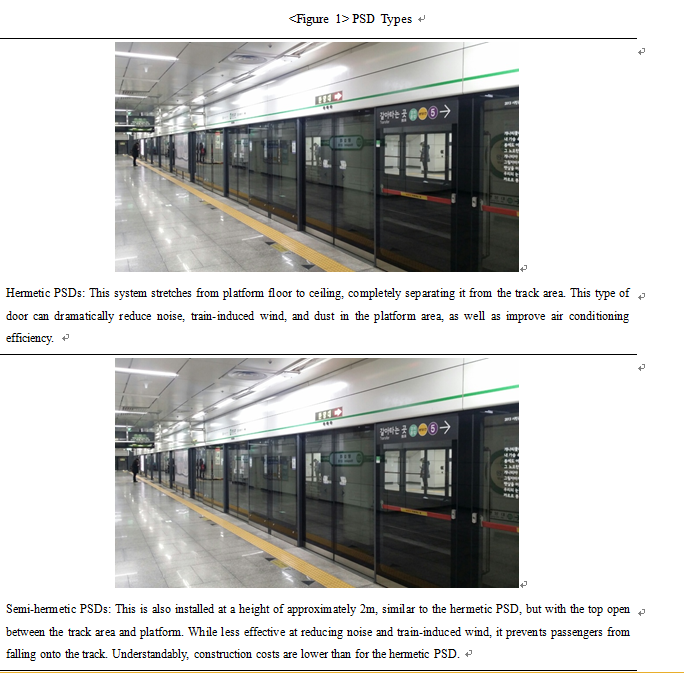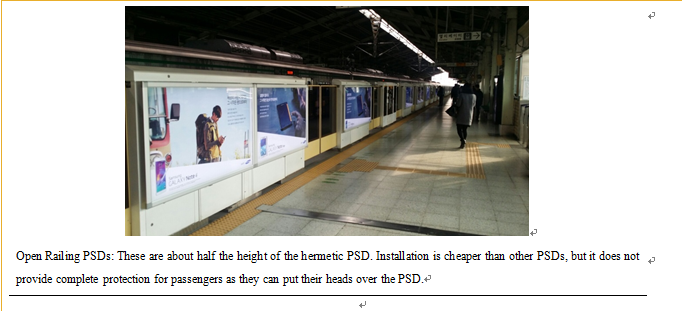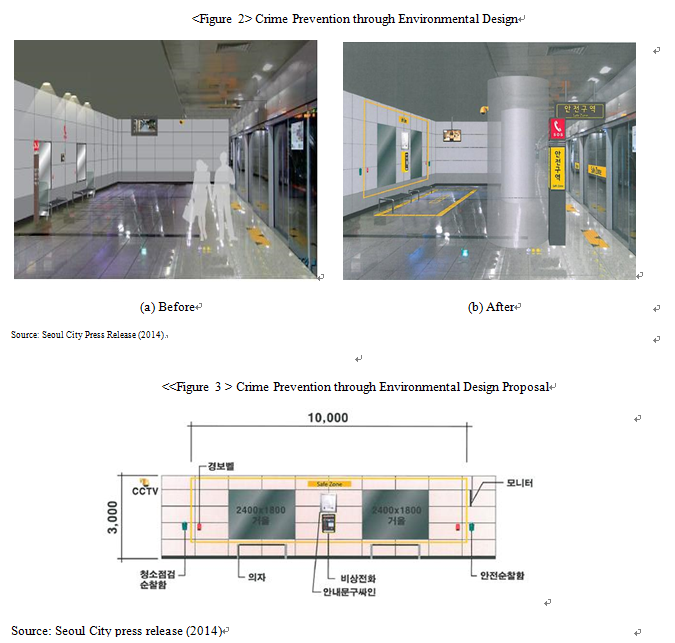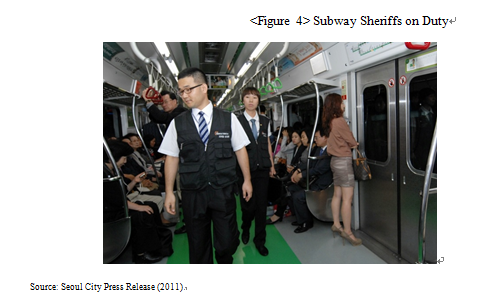مشروع أمان مترو الأنفاق في سيول للعمل المستمر على زيادة درجة الأمان
Background to Seoul's Subway Project
With the rapid industrial and social development in the early 1970s, population began to concentrate in urban areas. The urban population density caused traffic congestion and the subway system began construction as part of the measures to cope with the problem. After the opening of 9 subway stations on Line 1 in 1974, the system added Lines 2, 3 and 4 by 1985. By the time the secondary subway lines (5, 6, 7 and 8) were opened, the system was carrying over 6.3 million passengers a day, or 50% of Seoul's population. Each year, Seoul's subway system accounts for 35% of transportation share in the city. The number of passengers has more than doubled, both areas served and the number of subway stations have increased significantly.
Accidents related to safety on station platforms have soared with the dramatic increase of subway lines along with the increase in transportation share. Simple incidents such as engine breakdowns or delays have been replaced by falls from subway platforms, passengers caught in subway doors, collisions, fires, and equipment failures. Besides these, environmental pollution and noise in subway trains and on platforms have also increased. However, safety equipment has been insufficient to keep up with the rapid expansion of the subway system poor management of equipment.
<Table 1> Accidents on the Seoul Subway System (prior to 2003)
| Total | 1998 | 1999 | 2000 | 2001 | 2002 | 2003 | |
|
Total
|
652
|
85
|
93
|
87
|
92
|
148
|
147
|
|
Fatalities
|
296
|
39
|
49
|
34
|
54
|
50
|
70
|
|
Injuries
|
356
|
46
|
44
|
53
|
38
|
98
|
77
|
Source: Kim Sang-woon et al. (2004)
With increasing awareness of the public regarding subway safety and pollution, the Seoul Metro and Metropolitan Rapid Transit Corporation received KRW 36 billion from the city government in 2005 and began construction of platform screen doors the same year. PSDs (Platform Screen Doors) dramatically improve the environment around subway platforms; they block people from accessing the rail areas, thereby preventing rail-related fatalities, and also improve air quality by helping to contain fine dust. They also decrease noise and train-induced winds and the spread of fire, and save energy. Besides the PSD, Seoul Metro, the Metropolitan Rapid Transit Corporation, and Seoul Metro 9 (the three main Seoul subway operators) provide training and equipment to effectively respond to environmental changes and improve safety as part of subway safety projects.
Subway Safety Systems
PSDs (Platform Screen Doors)
Seoul City injected emergency funds into Seoul Metro and the Metropolitan Rapid Transit Corporation to rush PSD construction due to concerns about subway safety after the Daegu Subway Fire in 2003. As a result, the first PSDs were installed in Sadang Station by the end of 2005, and the city announced plans to install PSDs in every subway station by 2010. However, with ongoing and frequent casualties during the PSD construction period, the city had to accelerate its plans, installing them on 120 Seoul Metro platforms (Lines 1-4), 148 Seoul Metropolitan Rapid Transit platforms (Lines 5-8), and 25 Seoul Metro 9 platforms in 2009.
There are four main benefits to PSD installation: First, passenger safety. With the increase in demand for transportation, the existing platforms were congested and the close proximity between passengers and rail lines created frequent contact with subways or falls as a train approached a station. Such risk, however, can be prevented if PSDs are installed between platform and passengers. In the event of fire in a subway train, the PSDs can be closed to restrict the spread of gases and smoke while allowing passengers to evacuate the train. Second, PSDs facilitate safer operation of the subway trains. Since passenger safety has been secured, the train operator is better able to concentrate on operation of the train, which will help to ensure their own safety. Third, PSDs provide a pleasant station environment, as passengers can know that both contamination and noise levels are reduced. Fourth, PSDs assist energy saving efforts. The doors keep heat generated from the trains out of the platform area and prevent the outflow of cool air from the train into the tunnel, thereby reducing cooling load.
In general, the structural components of PSDs are fixed partitions, doors, driving gears, safety devices, a central control panel, and a display console. Fixed partitions are designed to withstand pressure from both crowds of passengers and from the trains; the design also combines supports and transparent glass to ensure visual openness of the tracks and platforms. Each PSD is a set of two sliding power doors with pressure-resistant transparent glass. The driving gear receives signals from the control panel to open and close the system through automatic interlocking; the initial design also considers maintenance, durability, and precision. Safety devices are designed to set off an alarm and open the doors in the event of safety issues, such as passenger belongings caught in the door while getting on or off the train. The gap between platform and PSD is generally less than 10 cm; however, this gap widens to 10 cm or more at curves in the platform structure, both ends of a platform where the PSD control equipment and monitors are installed, and platforms servicing both passengers and freight.
As shown in Figure 1 below, there are three types of PSD - hermetic, semi-hermetic, and open railing. The hermetic PSD is used at most subway stations: although initial investment and maintenance costs are high this type is most suitable for blocking train and mechanical ventilation noise and maintaining air conditioning efficiency. Semi-hermetic and open railing screen doors are used at ground level stations and carry lower initial investment costs than hermetic PSDs. These types of PSD are used where additional air conditioning systems are not in operation, and focuses on passenger safety and less on blocking train-induced wind and noise.
CPTED (Crime Prevention Through Environmental Design)
Seoul City endeavors to prevent subway crimes - over 2,000 cases each year - to enhance station comfort and safety. In June 2014, it announced introduction of the CPTED program in five stations on Line 9 (making the line the first place for CPTED application in public transit) and establishment of the Station Crime Prevention Guidelines. Seoul City established safety zones (5m long and 2m wide) in train platforms and is planning to install CCTV (closed-circuit television), emergency phones, emergency alarms, large mirrors, and monitors to discourage crime and respond quickly when it does occur.
In order to enhance effectiveness of the CPTED program, analysis was done of the correlation between crimes occurring on subway lines 1-8 and 209 stations from 2009 to 2012 and station space, and consulted with experts to identify potential countermeasures. The effectiveness of the CPTED program in preventing crime provides peace of mind to late night/early morning subway travelers. Based on its experience with installing platform safety zones, the city government will apply the CPTED program to Line 9 Phase 3 stations and light railway platforms after establishing subway station crime Prevention Guidelines.
Subway Sheriff System
The Subway Sheriff System is another response to subway crimes and was established by the city to assist with public order, creation of a pleasant subway environment, and help the elderly and the disabled. Sheriffs receive a variety of training, such as countermeasures against crime, firefighting, first aid, and crime and accident prevention. Since 2011, of the 4 subway lines (lines 1-4) operated by Seoul Metro, under the control of Seoul City, approximately 40 subway sheriff have been dispatched to lines 1 and 2. In 2012, the Subway Sheriff System was expanded to the lines run by the Seoul Metropolitan Rapid Transit Corporation, and the number of sheriffs doubled. Seoul Metro 9 also adopted the sheriff system after its opening in 2009. Illegal activity dealt with by subway sheriffs between 2011 to Jan. 2012 include soliciting (6,726 cases), public drunkenness (4,759 cases), newspaper collection (3,854 cases), begging (2,211 cases), and sleeping out in the open (1,997 cases). Any person caught by a subway sheriff for illegal activity will be taken to the Police Task Force and freed after reproof or payment of a fine.
Station Safety: Hands-on Experience
Seoul Metropolitan Rapid Transit Corporation is operating a hands-on program for vulnerable transportation users, such as children and the elderly who are frequently exposed to safety issues or inconvenience. The Metro Safety Experience Class provides training on theory and practical experience on subway safety, general use of the subway, fire extinguisher handling, emergency phones, ticket vending machines, and public transportation etiquette. Through visits to urban rail facilities such as stations and depots, participants can increase their understanding of subway operations and safety regulations. Other topics include operation of the subway emergency doors in the event of fire, and advice on what to do in the event of an actual accident or disaster.
CBTC (Communication Based Train Control)
The CBTC of the Seoul subway lines 5-8 operated by Seoul Metropolitan Rapid Transit Corporation was using a fixed block for train detection of the main section. While the method offers excellent stability, it creates a distance loss as much as the track circuit length in terms of absolute position detection of train; thus it is rather inaccurate, causing higher maintenance costs due to the need for more equipment onsite and in the signal machine room. In order to overcome these limitations and actively convert to a new system, the Seoul Metropolitan Rapid Transit Corporation developed a new radio-based train control system and has begun trial operations with it in three areas of Line 8. This new Train Control System consists of a train detection system that can accurately and continuously relay train location and speed, and a system that controls train using information transmitted through radio communication. The system is still in the pilot phase, but once it is developed all train control will become fully-automated and unmanned operation, which is expected to result in improved cost savings, safety, efficiency, maintainability, and passenger convenience over the existing block systems. Continuous developments in railway system engineering are expected to continue effectively decreasing safety problems.
Main Achievements
As a result of a variety of subway safety measures, PSDs have been installed in all subway stations in Seoul, providing a comfortable subway environment for subway users and workers. Starting with Sadang station in 2006, PSDs have been installed on 120 platforms on Lines 1-4 (Seoul Metro), 148 platforms on lines 5-8 (Metropolitan Rapid Transit Corporation), and 25 platforms of Seoul Metro Line 9. As of the end of 2009, PSDs had been installed in all subway stations. Prior to installation, at least 30 people had been injured or killed from suicide attempts or falls from the subway platforms. After installation, however, platforms and tracks are separated and the number of suicides or injuries due to falling on tracks has dramatically decreased.
|
(As of July 2012)
|
|||||
| Total stations | Total stations with PSDs | Ground Subway Station | Underground Subway Station | ||
|
Hermetic PSDs
|
Semi-hermetic PSDs
|
Hermetic PSDs
|
Semi-hermetic PSDs
|
||
|
293
|
293
|
269
|
0
|
22
|
2
|
| Total | 2009 | 2010 | 2011 | 2012 | |
|
Total
|
65
|
57
|
8
|
3
|
4
|
|
Fatalities
|
31
|
29
|
2
|
1
|
0
|
|
Injuries
|
34
|
28
|
6
|
2
|
4
|
Source: Rail Safety Information System (http://www.railsafety.or.kr)
|
Year
|
2007
|
2008
|
2009
|
2010
|
2011
|
2012
|
|
Number of Suicides
|
56
|
37
|
44
|
0
|
2
|
0
|
Source: Korea Railroad Corporation (2012)
Seoul Metro, the Seoul Metropolitan Rapid Transit Corporation, and Seoul Metro 9 have a variety of safety equipment on their trains and platforms and provide guidance and training programs through their websites or Internet blogs. In terms of safety equipment, three portable emergency flashlights are furnished every 25m, fire extinguishers every 20m on platforms and in transit lounges. A total of 334 gas masks are furnished in each station and 792 sprinkler heads in 4.6m intervals of transit lounge ceilings to assist subway users in evacuation during fire or emergency.
Station air quality has improved, as has the station environment through reduction of noise and fine dust. The city also endeavors to monitor air quality by measuring temperature, humidity, and fine dust in real time with sensors installed on platforms and transit lounges. The fine particle readings in Seoul Metro transit lounges was an average of 131.4㎍/㎥ before the PSDs were installed, and an average of 80.4㎍/㎥ after installation, a decrease of 35.3%. There has also been a reduction of radon each year. The lowest measurements in Seoul subway stations were in 2010, the year after the PSDs were installed, and these levels are still maintained today. The average concentration of radon for the 10 years between 2000 and 2009 was 2.76pCi/L, while measurements taken after installation of the PSDs in 2010 and 2011 showed concentrations of 1.12pCi/L, a reduction of 59.4%. Noise, too, decreased at all stations, although the degree varied by PSD type. Specifically, stations where hermetic PSDs had been installed recorded noise levels an average of 7.3 dB less than before. In Seoul Metro stations, noise levels dropped from 78.3 dB to 72.1 dB (7.9% reduction). Ventilation and air conditioning costs also decreased by 18% while electricity costs dropped 33% (from KRW 19.447 billion to KRW 13.055 billion).
Limitations & Needed Improvements
The safety of Seoul Subway has reached advanced nation levels thanks to projects promoted by various organizations and increased awareness of the average person regarding safety. However, incidents still occur with the potential to lead to larger events, such as malfunctioning stop signals causing train derailment, passengers setting fires in trains, passengers caught in screen doors, etc. Other problems are also being pointed out besides safety, such as maintenance costs and maintenance work required for the PSDs.
Several important steps need to be taken to prevent recurrence of accidents: First, it is not necessary to build a safety management system that prevents errors and accidents that have been frequent by human (human error), which is an ongoing problem. Enhanced surveillance and alarm systems are needed, particularly remote monitoring and alarm systems for facilities and unmanned machinery rooms in tunnels and bridges, which are difficult for personnel to monitor constantly. Second, aging trains need to be replaced. As of 2013, 600 of the 1,945 vehicles running on lines 1-4 are at least 21 years old, which has been pointed out as a cause for the frequency of recent breakdowns. Trains deemed to be at high risk of causing incidents need to be repaired or replaced, even if they are not past their intended service term. Third, as Seoul's subway system is managed by separate operating entities, an integrated control center is necessary to resolve inadequate safety measures and unsafe operations. Fourth, Golden-time Targeting Program should be introduced for quick safety action in the subway system. A system needs to be designed that will reduce emergency response to five minutes or less to contain situations, protect people, and take other emergency action. This system would also include better training for employees, and standardization of working procedures.
References
Kim Sang-woon, Sung Ki-chang, Kang Byung-geum, 2004 “A Study on Introduction of Platform Screen Doors in Subway Stations”, Korea Institute of Healthcare Architecture
Seoul Institute of Health & Environment, 2011, " Noticeable Change in Indoor Radon Levels After Installation of Platform Screen Doors in Seoul Subway Stations"
Seoul City press release, 2011, “Commencement of the Seoul Subway System Sheriff Program to make safe subway”
Korean Railroad Corporation, 2012, “Suicides & Platforms Screen Door Installation”
Seoul City press release, 2014, “Crime Prevention Through Environmental Design: Application to Subway line No. 9, the stations on the 2nd step”



